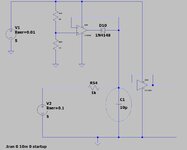cupoftea
Advanced Member level 5
Hi,
Isnt it strange that you cant have a capacitor of >~100n at an opamp output, but if its an opamp clamp (as attached), then you can have a cap as big as you like.
Why is this?
Isnt it strange that you cant have a capacitor of >~100n at an opamp output, but if its an opamp clamp (as attached), then you can have a cap as big as you like.
Why is this?
LTspice also here...
Version 4
SHEET 1 7004 1720
WIRE -3776 -896 -4048 -896
WIRE -3616 -896 -3776 -896
WIRE -3248 -896 -3616 -896
WIRE -3776 -848 -3776 -896
WIRE -3392 -800 -3680 -800
WIRE -3616 -752 -3616 -896
WIRE -4048 -736 -4048 -896
WIRE -3680 -736 -3680 -800
WIRE -3648 -736 -3680 -736
WIRE -3520 -720 -3584 -720
WIRE -3392 -720 -3392 -800
WIRE -3392 -720 -3456 -720
WIRE -3776 -704 -3776 -768
WIRE -3648 -704 -3776 -704
WIRE -3776 -672 -3776 -704
WIRE -4048 -592 -4048 -656
WIRE -3776 -512 -3776 -592
WIRE -3616 -512 -3616 -688
WIRE -3184 -448 -3312 -448
WIRE -3248 -416 -3248 -896
WIRE -3312 -400 -3312 -448
WIRE -3280 -400 -3312 -400
WIRE -3184 -384 -3184 -448
WIRE -3184 -384 -3216 -384
WIRE -3056 -384 -3184 -384
WIRE -3584 -368 -3856 -368
WIRE -3392 -368 -3392 -720
WIRE -3392 -368 -3504 -368
WIRE -3280 -368 -3392 -368
WIRE -3392 -304 -3392 -368
WIRE -3856 -272 -3856 -368
WIRE -3856 -64 -3856 -192
WIRE -3520 -64 -3856 -64
WIRE -3392 -64 -3392 -240
WIRE -3392 -64 -3520 -64
WIRE -3248 -64 -3248 -352
WIRE -3248 -64 -3392 -64
WIRE -3040 -64 -3248 -64
WIRE -3520 -32 -3520 -64
FLAG -3616 -512 0
FLAG -3776 -512 0
FLAG -4048 -592 0
FLAG -3520 -32 0
SYMBOL Opamps\\LT1006 -3248 -448 R0
SYMATTR InstName U23
SYMBOL res -3488 -384 R90
WINDOW 0 0 56 VBottom 2
WINDOW 3 32 56 VTop 2
SYMATTR InstName R54
SYMATTR Value 1k
SYMBOL Opamps\\LT1006 -3616 -784 R0
SYMATTR InstName U25
SYMBOL diode -3456 -736 R90
WINDOW 0 0 32 VBottom 2
WINDOW 3 32 32 VTop 2
SYMATTR InstName D10
SYMATTR Value 1N4148
SYMBOL res -3792 -864 R0
SYMATTR InstName R55
SYMATTR Value 4k
SYMBOL res -3792 -688 R0
SYMATTR InstName R57
SYMATTR Value 1k
SYMBOL cap -3408 -304 R0
SYMATTR InstName C1
SYMATTR Value 10µ
SYMATTR SpiceLine Rser=0.03
SYMBOL voltage -4048 -752 R0
WINDOW 123 0 0 Left 0
WINDOW 39 24 44 Left 2
SYMATTR InstName V1
SYMATTR Value 5
SYMATTR SpiceLine Rser=0.01
SYMBOL voltage -3856 -288 R0
WINDOW 123 0 0 Left 0
WINDOW 39 24 44 Left 2
SYMATTR InstName V2
SYMATTR Value 5
SYMATTR SpiceLine Rser=0.1
TEXT -4082 -8 Left 2 !.tran 0 10m 0 startup
CIRCLE Normal -3312 -160 -3472 -368 2
